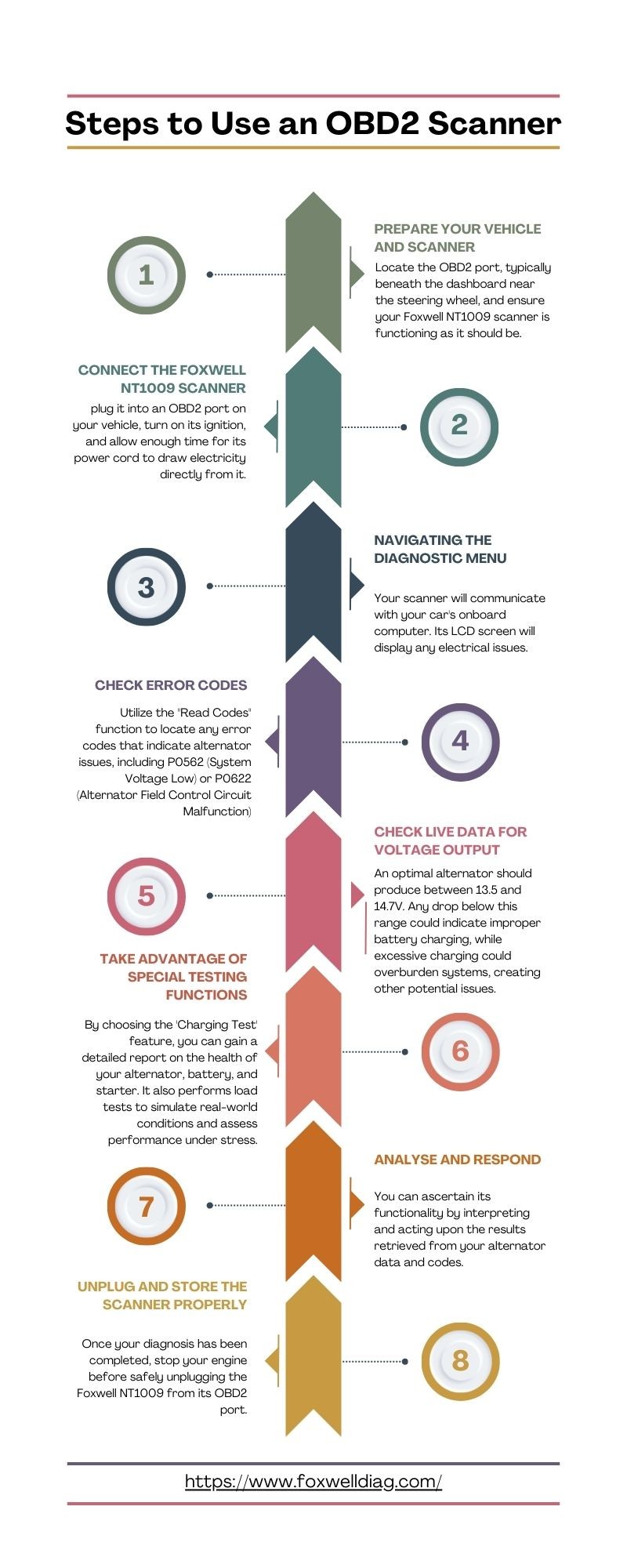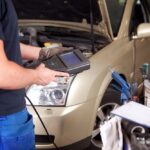Experiencing flickering headlights or a car that struggles to start? A failing alternator could be the culprit. Before you rush to the mechanic, you might be wondering if your trusty OBD2 scanner can help diagnose the problem. The good news is, yes, an OBD2 scanner can be a valuable tool in testing your alternator, with a few things to keep in mind.
This guide, created by the auto repair experts at carparteu.com, will walk you through how to use an OBD2 scanner, such as the Foxwell NT1009, to check your alternator’s health. We’ll cover the steps involved, what to look for, and when you might need to consider alternative testing methods. Understanding your alternator and how to assess it is crucial for maintaining your vehicle’s electrical system and avoiding unexpected breakdowns.
Understanding the Vital Role of Your Vehicle’s Alternator
Think of your car’s alternator as the heart of its electrical system. Just like your heart pumps blood to keep your body running, the alternator generates electricity to power all sorts of electrical components in your vehicle. This includes everything from your headlights and radio to critical systems like your engine management and power windows.
A healthy alternator ensures your battery stays charged while the engine is running. However, alternators, like all car parts, have a lifespan. When they start to fail, you might notice symptoms such as dimming headlights, slow engine cranking, or a battery that keeps dying even after being charged. Ignoring these warning signs can lead to a completely drained battery and leave you stranded. Early detection of alternator issues can save you from more significant problems and costly repairs down the road.
Can an OBD2 Scanner Actually Diagnose Alternator Issues?
An OBD2 scanner, like the Foxwell NT1009, is an incredibly useful tool for diagnosing various car problems, including potential alternator issues. These scanners work by reading diagnostic trouble codes (DTCs) stored by your car’s computer. These codes are generated when the car’s computer detects something isn’t working correctly within the vehicle’s systems.
While an OBD2 scanner won’t directly say “Your alternator is bad,” it can provide valuable clues. It can detect electrical system faults that are often related to alternator problems. For example, codes like P0562 (Low System Voltage) or P0622 (Alternator Field Control Circuit Malfunction) can strongly suggest an alternator issue. These codes act as indicators, pointing you in the right direction for further investigation and helping you determine if the alternator is indeed the source of the electrical problems you’re experiencing. It’s about using the scanner to gather evidence and guide your diagnostic process.
Step-by-Step Guide: Using an OBD2 Scanner to Check for Alternator Problems
Here’s a detailed guide on how to use your OBD2 scanner to assess your alternator, using the Foxwell NT1009 as an example:
1. Prepare Your Vehicle and Scanner
Before you begin, ensure your vehicle is safely parked and the engine is off. Turn off all unnecessary electrical loads like headlights, radio, and air conditioning. This minimizes electrical draw during the test and provides a more accurate reading. Next, make sure your Foxwell NT1009 scanner is ready to use, with charged batteries or properly connected to a power source if needed.
2. Connect the Foxwell NT1009 Scanner
Locate the OBD2 port in your vehicle. It’s typically found under the dashboard on the driver’s side, near the steering column. Plug the Foxwell NT1009 scanner firmly into the OBD2 port. Turn your car’s ignition to the “Key On, Engine Off” (KOEO) position. This powers up the car’s computer and allows the scanner to communicate with it without starting the engine. Give the scanner a moment to initialize and establish a connection with your vehicle’s system.
3. Navigate to the Diagnostic Menu
Power on your Foxwell NT1009 scanner and navigate through its menu to find the “Diagnostic” or “OBDII/EOBD” section. Select this option. You might be prompted to enter your vehicle’s make, model, and year for more precise diagnostics. Follow the scanner’s prompts to input this information accurately. This step ensures the scanner is using the correct vehicle-specific data for diagnosis.
4. Check for Error Codes
Within the diagnostic menu, select the “Read Codes” or “Trouble Codes” option. The scanner will communicate with your car’s computer and display any stored diagnostic trouble codes. Look for codes that are relevant to the electrical system or charging system, such as:
- P0562: System Voltage Low: This code indicates that the system voltage is lower than expected, which could be a sign of a failing alternator not producing enough power.
- P0622: Alternator Field Control Circuit Malfunction: This code suggests a problem within the alternator’s control circuit, which could prevent it from charging properly.
Note down any codes you find. These codes are valuable clues, but they don’t definitively confirm a bad alternator. They indicate areas that require further investigation.
5. Check Live Data for Voltage Output
One of the most useful features of an OBD2 scanner for alternator testing is its ability to display live data. Navigate to the “Live Data” or “Data Stream” section in your scanner’s menu. Look for parameters related to voltage, such as “Battery Voltage,” “System Voltage,” or “Alternator Voltage.”
Start your car’s engine. Observe the voltage readings on the scanner. A healthy alternator should typically produce a voltage output between 13.5 and 14.7 volts when the engine is running.
- Low Voltage (below 13.5V): If the voltage is consistently below this range, it could indicate that the alternator is not charging the battery effectively.
- High Voltage (above 14.7V): While less common, excessively high voltage can also be problematic and might point to a voltage regulator issue within the alternator.
To further assess the alternator’s performance under load, turn on various electrical accessories like headlights, air conditioning, and the radio while monitoring the voltage. A significant drop in voltage when these loads are applied can indicate a weak or failing alternator struggling to keep up with the electrical demand.
6. Take Advantage of Special Testing Functions (If Available)
Some advanced OBD2 scanners, like the Foxwell NT1009, may offer specialized testing functions for the charging system. Explore your scanner’s menu for options like “Charging System Test” or “Alternator Test.” If available, these tests can provide a more comprehensive evaluation of your alternator, battery, and starter. These tests often perform load simulations to assess the alternator’s performance under realistic driving conditions and provide a more detailed report on the charging system’s health.
7. Analyze and Respond to the Results
After performing these tests, carefully analyze the data you’ve collected from the error codes and live voltage readings.
- Normal Readings: If the voltage readings are within the normal range (13.5-14.7V) and there are no relevant error codes, your alternator is likely functioning correctly. However, if you are still experiencing electrical issues, further investigation of other components might be needed.
- Abnormal Readings or Error Codes: If you observe low voltage readings, significant voltage drops under load, or relevant error codes like P0562 or P0622, it strongly suggests a problem with your alternator or charging system.
Based on your findings, you can decide on the next steps. If the tests indicate a problem, consider further testing or consult a qualified mechanic for a professional diagnosis and repair. After addressing any issues, you can use your scanner to clear any stored error codes.
8. Disconnect and Store the Scanner Properly
Once you have completed your diagnosis, turn off your car’s engine and carefully disconnect the Foxwell NT1009 scanner from the OBD2 port. Store your scanner in a safe and dry place, ready for its next use. Proper storage will ensure your scanner remains in good working condition for future diagnostics.
Alternative Methods to Test Your Vehicle’s Alternator
While an OBD2 scanner is a helpful initial diagnostic tool, there are other methods to test your alternator, especially if the scanner results are inconclusive or you want to confirm your findings.
- Multimeter Test: A multimeter is a simple and effective tool for directly measuring the voltage at your car battery. With the engine running, connect the multimeter to the battery terminals. A reading between 13.5 and 14.7 volts indicates the alternator is likely charging correctly. A reading below this range suggests a potential alternator problem.
- Load Test: A load test provides a more rigorous assessment of the alternator’s ability to deliver power under load. This test can be performed using a specialized load testing tool or by a professional mechanic. It measures the alternator’s output as electrical demand is increased, providing a more in-depth evaluation of its performance under stress.
Conclusion
An OBD2 scanner, such as the Foxwell NT1009, is a valuable first step in diagnosing alternator issues. It provides insightful data through error codes and live voltage readings, helping you understand if your alternator might be failing. However, it’s important to remember that an OBD2 scanner is not always a definitive diagnostic tool for alternators. It’s best used as an initial assessment tool, guiding you towards potential problems and providing data to inform further action.
In some cases, especially when dealing with complex electrical issues, additional testing methods like multimeter tests or load tests, or a professional mechanic’s expertise, might be necessary to pinpoint the exact cause of the problem. By combining the insights from your OBD2 scanner with other diagnostic techniques when needed, you can effectively maintain your vehicle’s electrical system, address alternator issues promptly, and prevent unexpected breakdowns and costly repairs. Regular use of your Foxwell NT1009 scanner can empower you to stay on top of your car’s health and ensure reliable performance.
FAQs
Can you test an alternator with an OBD2 scanner?
Yes, you can use an OBD2 scanner to test an alternator by checking for relevant trouble codes and monitoring live voltage data. While it might not provide a direct “bad alternator” diagnosis, it offers valuable information to assess the alternator’s performance and guide further testing.
Will a bad alternator show up on a scan?
A bad alternator may not always have a specific “bad alternator” code, but it can trigger related trouble codes on an OBD2 scan. Codes like “Low System Voltage” or “Alternator Circuit Malfunction” can indicate alternator problems that warrant further investigation.
Is there an OBD code for alternator?
Yes, there are OBD codes associated with alternator issues. Common codes include P0562 (System Voltage Low) and P0622 (Alternator Field Control Circuit Malfunction). These codes suggest potential problems with the alternator’s function and charging capability.

